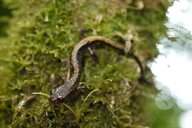|
Description
Pseudoeurycea saltator is one of the smallest salamanders in its genus. Snout to vent length is generally less than 45 mm (maximum length is 48 mm in females). Morphometrically and color pattern-wise, P. saltator most closely resembles P. longicauda and P. juarezi. Though P. longicauda is found in the Transverse Volcanic Range of central Mexico (Lynch et al. 1983), it differs from P. saltator in having shorter limbs and being larger, though they are similar in having a relatively long tail (both have a tail length/SVL ratio greater than 1). P. juarezi differs from P. saltator in occurring at higher elevations (2200-2900 m) and occurring south of the range of P. saltator (which is smaller and has a relatively longer tail). Pseudoeurycea saltator has a uniformly dark gray dorsal ground color with a paler mid-dorsal stripe (which varies from pale cream through different shades of tan, brown, or gray and is lighter posteriorly on some indviduals). Along the dorsal line, P. saltator has a characteristic conspicuous white or cream colored pigmentation at the tip of the tail. The underside of the tail is darker than the belly or the chin (which are both a pale gray). The skull is well ossified. The single premaxila contains a broad but slender pars dentalis that has four long spine-like teeth (each with a recurved labial cusp that extends beyond the smaller lingual cusp to form a hook-like structure (see Taylor, page 59 (1941) for a drawing of a similar tooth found in P. unguidentis and P. smithi which are also Oaxacan species). The frontal processes of the premaxilla develop independently and diverge to overlap with the frontals. A rather large fontanelle is formed. P. saltator has 1 atlas, 14 trunk vertebrae (13 rib-bearing), 1 sacral, 2 caudosacral, and 31 caudal. Distribution and Habitat
Country distribution from AmphibiaWeb's database: Mexico
Pseudoeurycea saltator is found in the humid Caribbean-facing slope of the Sierra de Juarez, in north central Oaxaca.Life History, Abundance, Activity, and Special Behaviors
The majority of the specimens were found in bromeliads up to 8 m above the ground; a few were found in loose bark from fallen branches. Habitat is that of an evergreen cloud forest. P. saltator is also a fast moving member of the genus (relative to its congeners). Possible reasons for amphibian decline General habitat alteration and loss
References
Lynch, J.F., Wake, D.B., and Yang, S.Y. (1983). ''Genic and morphological differentiation in populations of the salamander genus Pseudoeurycea inhabiting the Transverse Volcanic Range of Mexico, with a description of a new species.'' Copeia, 1983, 884-894.
Lynch, J.F., and Wake, D.B. (1989). ''Two new species of Pseudoeurycea (Amphibia: caudata) from Oaxaca, Mexico.'' Contributions in Science, Natural History Museum of Los Angeles County, 411, 11-22.
Taylor, E.H. (1941). ''New plethodont salamanders from Mexico.'' Herpetologica, 2.
Wake, D. B., and Elias, P. (1983). ''New genera and a new species of Central American salamanders, with a review of the tropical genera (Amphibia, Caudata, Plethodontidae).'' Contributions of the Natural History Museum of Los Angeles County, 345, 1-19.
Originally submitted by: Raul E. Diaz (first posted 2004-12-14)
Edited by: Kellie Whittaker (2007-03-19)Species Account Citation: AmphibiaWeb 2007 Pseudoeurycea saltator <https://amphibiaweb.org/species/4188> University of California, Berkeley, CA, USA. Accessed Jun 13, 2025.
Feedback or comments about this page.
Citation: AmphibiaWeb. 2025. <https://amphibiaweb.org> University of California, Berkeley, CA, USA. Accessed 13 Jun 2025.
AmphibiaWeb's policy on data use.
|



 Raffaëlli Account
Raffaëlli Account Map of Life
Map of Life